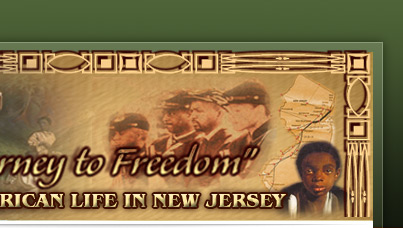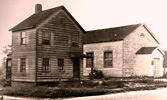 MT.
ZION BAPTIST CHURCH (1888), SALEM, NJ MT.
ZION BAPTIST CHURCH (1888), SALEM, NJ
In 1888, George Kelsic Sr., called to his home Edward
Brooks, Taswel Harris, George Curry and Griffin Garnet
to discuss organizing a Baptist church in Salem, New
Jersey. A few months later, these former Virginians
with a vision called Reverend Strand of Virginia to
come and pastor a small group of dedicated Christians.
He agreed and Mt. Zion was born.
The early church was held in what was known as the
"Old Pickle House" located on Howell Street.
The church grew rapidly in a dozen years under the leadership
of Reverends Strand, Holstead, "Cyelone" Robinson,
(so called for his fiery sermons and his uncanny predictions
of things to come) and R.D. Johnson. Reverend I.M. Holly,
D.D., the church’s fifth pastor, served from 1900 to
1952.
The church was moved from the "Pickle House"
to Rumsey Hall, at Broadway and Seventh streets in 1900.
Worship services were held there until the new church
was built on Union Street. The cornerstone was laid
in 1912. In 1878, the Mt. Pisgah AME congregation erected
this fine brick church in Salem. Mt. Pisgah is one of
he earliest congregations in the state, organized in
1800. The building is listed on the National Register
of Historic Places. It draws on a rich legacy of southern
New Jersey architecture, which is in turn derived from
the Georgian traditions of Philadelphia. Gouldtown,
in Cumberland county, was an important early black community.
Appropriately, it is the site of one of the most interesting
black churches, Trinity AME. A traditional meetinghouse
in the style of the Springfield Presbyterian church,
it was erected about 1860.
SOURCE: ZION BAPTIST CHURCH, MT. PISGAH AME AND GOLUDTOWN,
1999
SECOND BAPTIST CHURCH (1895), FREEHOLD, NJ
The Second Baptist Church was birthed into ministry
in 1895 in the house of Deacon David Paterson. Those
dedicated to the ministry also included John Simmons,
Marshall Simmons, Joseph Baskerville, Thomas Baskerville,
John Jones, Richard Ward and many women who worked with
them. When the mission grew and a larger facility was
needed, a building was rented on Mechanic Street. By
1897, the Second Baptist Church was officially organized.
In July 1899, Brothers Walter A. Mosely, John Jones,
Edward Lewis, Edward Simmons, and Joseph Smith filed
for incorporation papers. In 1904, the first church
building was erected on Throckmorton Street and the
church called its first pastor, Reverend D.H. Mitchell.
SOURCE: SECOND BAPTIST CHURCH, 2001
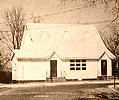 ST.
THOMAS EPISCOPAL CHURCH (1891), RED BANK, NJ ST.
THOMAS EPISCOPAL CHURCH (1891), RED BANK, NJ
Bishop Scarborough reported to the Diocesan Convention
of 1892 on the founding of St. Thomas Chapel on December
21, 1891. The Durham family who built the church was
prominent members of Trinity Episcopal Church where
the Elder Thomas Durham was a lay reader. The family
owned a considerable amount of property in the vicinity
of Catherine Street where they built the church named
for St. Thomas the Apostle. The intent was that this
church would function as a daughter chapel to Trinity
with Reverend Robert McKellar, the rector of Trinity,
in charge.
It is not clear why, but the chapel fell into disuse
after a few years. By this time, a group of Black Episcopalians
had begun meeting in Red Bank. They applied for and
were granted permission by the Bishop to use the chapel
for worship, and were greatly assisted in this effort
by Fr. A.E. Jenson of St. Augustine's, Asbury Park,
as well as by Fr. McKellar. After this reorganization,
the first service was held on June 9, 1907.
A year later, during a large service to celebrate the
first anniversary of St. Thomas’s reorganization and
revival, Mrs. Durham presented the congregation with
the deed for the land and building. The church lot was
a frame structure described as "Modified Gothic."
The lot and building were valued at $4,000 and were
debt free.
Though originally started as a church for White people,
it was as a predominantly Black congregation that St.
Thomas took root and grew. In fact, many Black churches
and other social institutions were either started or
revitalized in this area during these years, including
a number of other predominantly Black parishes in the
Diocese such as St. Augustine's in Camden, 1889, and
St. Augustine's in Asbury Park, 1890. This occurred
because there was a large scale migration of Black people
into New Jersey from the South between 1870 and 1910,
many of whom were attracted to the shore area, particularly
Long Branch and Asbury Park
SOURCE: ST. THOMAS EPISCOPAL CHURCH, 2001
REEVEYTOWN A.M.E.ZION CHURCH (1882) TINTON
FALLS, NJ
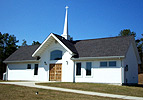 Reeveytown
was settled by the Reevey's and Richardson families
in 1882. The first pastor was Rev. J.P. Thompson. The
first funeral was that of Emiline Richardson, March
3, 1890, at the age of seventy years young. The first
wedding was Miss. Georgina Reevey to Mr. DuBoise. the
first Sunday School Superintendent was Hannah Richardson.
According to tradition, one of the early settlers of
the area was Issac Reevey Richardson, a Cherokee Indian
Chief who migrated from North Carolina. The town's name
originated from Reeveytown
was settled by the Reevey's and Richardson families
in 1882. The first pastor was Rev. J.P. Thompson. The
first funeral was that of Emiline Richardson, March
3, 1890, at the age of seventy years young. The first
wedding was Miss. Georgina Reevey to Mr. DuBoise. the
first Sunday School Superintendent was Hannah Richardson.
According to tradition, one of the early settlers of
the area was Issac Reevey Richardson, a Cherokee Indian
Chief who migrated from North Carolina. The town's name
originated from
the large families of Reeveys.
There were many large families of Reeveys in the area:
and, it was known as Reeveytown. Elsie Reevey provided
a piece of ground to build a church on Shafto Road.
The church didn't have a deed. So, John Brown and Leonard
Sammons, (Both now deceased). Brought property in Reeveytown,
including the property where the church was located,
and gave the church a deed. Reeveytown Church is a Christian
Monument to the Reeveys and Richardson families.
Camp Meetings was one of the outstanding Autumn's events
in Reeveytown, that neighbors, friends and relatives
came from miles around on their horses and wagons to
attend the yearly event. Quite a few people didn't know
where Reeveytown was until the meat shortage. During
World 11, meats were rationed. There was an Abattoir
in Reeveytown and anyone could get all the meats they
wanted. Many people inquired where Reeveytown was, and
since then it’s been put on the map as an historical
land mark in the State of New Jersey.
In October 1994, the white shingled church with its
red front door, built by members of the community in
1882, was demolished to make room for the expansion
of the nearby Monmouth County Reclamation Center. Even
though the original church building is now gone, the
congregation is sitting on a new site at Shafto Road.
Down through the years; from 1882 to present, are some
of the known Ministers that faithfully served at Reeveytown:
- Rev. J.P. Thompson Rev. J. Carr Rev. C.L. Clemons
- Rev. K.F. Butler Rev. Black Rev. Hogan
- Rev. Johnson Rev. Murphy Rev. J.E. Kelley (Second
Term)
- Rev. P. Hicks Rev. J.E. Kelley Rev. I.H. Greene
- Rev. Lewis Rev. Ramsey Rev. Edward Starks to Present
- Rev. Robert Rev. Butlerworth
SOURCE: REEVEYTOWN A.M.E. ZION CHURCH,
2001
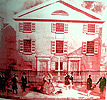 BISHOP
RICHARD ALLEN (1760-1831), FOUNDER OF MOTHER BISHOP
RICHARD ALLEN (1760-1831), FOUNDER OF MOTHER
BETHAL A.M.E. CHURCH PHILADELPHIA, PA
Richard Allen, the first bishop of the A.M.E. Church,
was born February 14, 1760, enslaved by a Benjamin Chew
of Philadelphia, Pennsylvania. At an early age, he with
his father, mother and three other children, was sold
into the state of Delaware, where, on a farm in the
neighborhood of Dover, he was brought up. About 1777,
he was converted and soon afterwards, about 1780, he
began to preach. His religion was of such a genuine
sort that it affected every department of his life.
As a result his owner permitted prayer meetings and
preaching in his house, and was converted himself. The
slaveowner showed his conversion by making it possible
for his slaves to become free. Accordingly Richard Allen
and his brother bought their freedom for $2,000.00 continental
money.
Now a free man, Richard Allen began working for himself,
cutting cord wood; earning $50 (continental money) a
month in a brick yard, working as a day laborer and
then as a teamster hauling salt during the Revolutionary
War from Rehobar, Sussex County, Delaware. During all
of this time, he preached whenever he could. After he
had acquired experience, he began to travel from place
to place preaching. Like the apostle Paul, he worked
with his hands for his own support as he preached. In
the fall of 1783, he was in Wilmington, Delaware. Later
and until spring of 1784, he traveled and preached in
New Jersey, after which he traveled and preached in
Pennsylvania.
In February 1786, he came to Philadelphia and preached
at St. George's Methodist Church and at different places
in that city where there was a large colored population.
It was out of St. George's Church that Allen and his
followers marched. This was the protest and in March
which caused the birth of African Methodism. "On
June 6, 1831 Bishop Richard Allen died and went to heaven,
to meet God." (For more on Richard Allen and Mother
Bethel A.M.E. Church, see Slavery in Pennsylvania.)
SOURCE:MOTHER BETHEL A.M.E. CHURCH, 2004
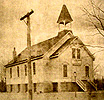 ROSSVILLE
A.M.E. ZION CHURCH (1824), STATEN ISLAND, NY ROSSVILLE
A.M.E. ZION CHURCH (1824), STATEN ISLAND, NY
The town of Sandy Ground in Staten Island, New York,
formed in the early 1800s by Black oyster fishermen
who were fleeing the restrictive laws of the State of
Maryland. These oyster fishermen and their families
joined with freed slaves from Staten Island, Manhattan
and New Jersey to form the town of Sandy Ground. Sandy
Ground grew and became the center of economic and social
life for Blacks living on the Eastern Seaboard. The
Rossville A.M.E. Zion Church was formed shortly after
the arrival of the oystermen. The church still functions
as an active religious center in the community.
(For more about Sandy Ground, see Slavery in New York.)
SOURCE: ROSSVILLE A.M.E. ZION CHURCH, 2004
|
